here’s why I made the move and how I transport my trike as a full-time RV Traveler in a 5th Wheel –
Here’s my story…
First, its been a few weeks since I last posted. I’ve been enjoying life and traveling – now into South Dakota. Read through this most in-depth article – towards the end, I tell you a bit about where I am, what its like here, and why I will likely return! A one week stay has turned into a month (and possibly a few days longer!) But, before that… here’s my tale on bicycles, bicycling, and my NEW trike! Enjoy, Al.
I’ve been a bike (bicycle) rider since I was a kid. I can still remember my Schwinn Stingray (I wish I still had that knowing what they’re worth now!) and my first “racing style” (upright) bike, a Schwinn Continental. I still remember the bright yellow colors and was so proud that it was a 24 speed, riding it around my town (and far farther) as a young teenager.
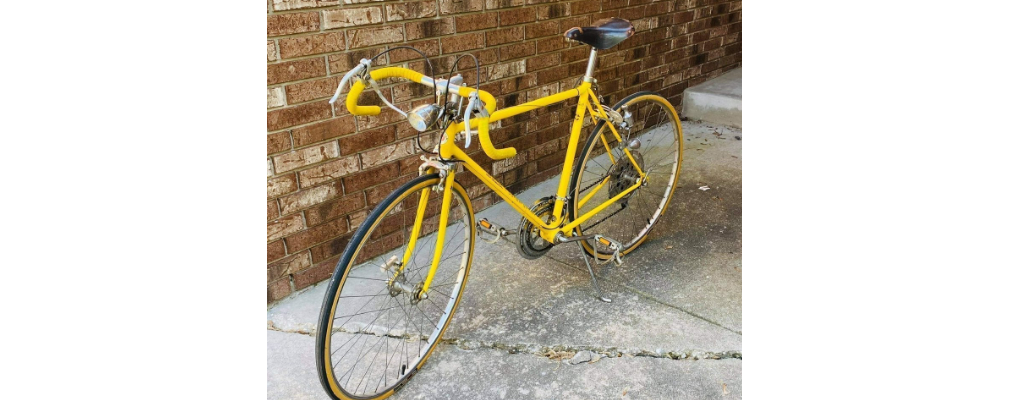
Bicycling has always been a great source of exercise for me as well as a way to get around along with being a way to relax and simply enjoy being outdoors. I can still remember riding my Continental in the pre-dawn hours as a 14 year old going to and from my first job – through slushy roads and in a driving rain/snow storm!
Cross-State Bike Tours – and a touch of age…
By 1993, I was in my mid 30’s and discovered cross-state bike tours. My first ride was the Shoreline of Lake Michigan. Seven days of about 60 – 70 miles per day. A rolling party! It actually became a summer ritual and I met many great people there. By 1998 and the arrival of my 40th birthday, my lower back had had enough of long rides on an upright (traditional “10 speed” type) bike – essentially a refined version of my Continental. It was on these rides, I saw these “old guys” in their late 50’s and 60’s who were riding these “things” I’d never seen before. They turned out to be recumbent bikes – and some of these “older” guys were able to kick my butt climbing hills!
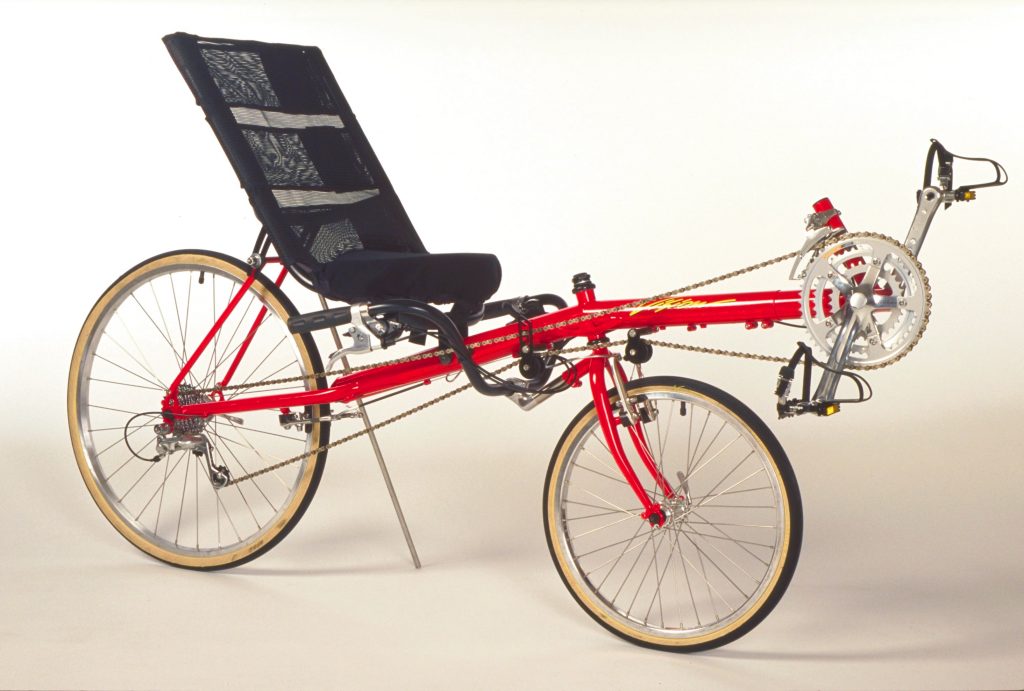
Almost immediately after being exposed to recumbent bikes, I bought my first, a Vision R-42, and then a Sun, and most recently a front-wheel drive Cruzbike. The Cruzbike is a REALLY good, responsive and comfortable recumbent, but the time has come to replace it with a trike. My primary motivating factor? An explosive blowout of the front tire that resulted in an immediate fall without time to even get out of my spd (clip) pedals.
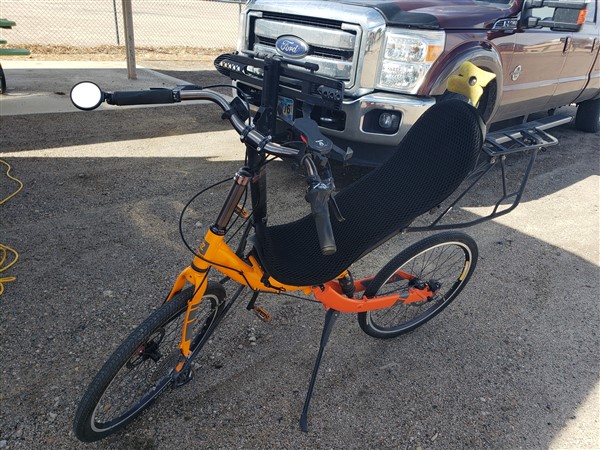
The resulting damage, fortunately all soft-tissue was significant enough, and slow-healing enough to encourage me to look into trikes. And look I did. I visited a small trike store in Austin, Tx. (I was spending the winter in the Texas hill country at the time) and test rode a Terra Trike and a Cattrike.
Bike riding and RV Life
A brief side tour – as a 60+ RV’er, I realize that staying in shape and cardio-vascular exercise are important goals that must be addressed daily. THIS is largely why I continue to ride today and my venture into the world of recumbent trikes is intended to allow me to do this safely – and – comfortably for years to come!
Considering a Trike for yourself? Here’s an opportunity to REALLY geek out!
Trike Test Rides…
While the trike shop in Austin was the wrong shop to ultimately do business with, my brief test rides were sufficient to confirm I was on the right track. A week or so later, I decided to visit Johns Trikes & Bikes in Lancaster, Tx. Johns’ maintains an excellent fleet of demo trikes to try out and their staff is well suited to helping folks. If you’re in the Dallas “metroplex” region, I highly recommend them.
Trikes I test rode at John’s – Tip: Selecting the RIGHT TRIKE for YOU!
Test rides are VITAL when selecting a recumbent trike, and most bike shops that specialize in trikes maintain a fleet of demo trikes. Johns Trikes in Lancaster, Tx. is particularly well equipped with demo bikes. They and the other bike shops I spoke to however do not maintain much inventory – in part because of supply chain issues and in part because many buyers want to customize their choices. When you ultimately decide upon “the” trike for you, be prepared to order it (there are often many options to consider, and the build time could require 4 months or more (at the time of this writing – early summer 2021.)
With hours blocked out for test riding, I started out on a “chilly” February morning (mid-40’s) looking at Catrikes at John’s while also considering how they fold and can “travel.” As a traveler in a 5th wheel, I was initially curious about how I will be able to transport.
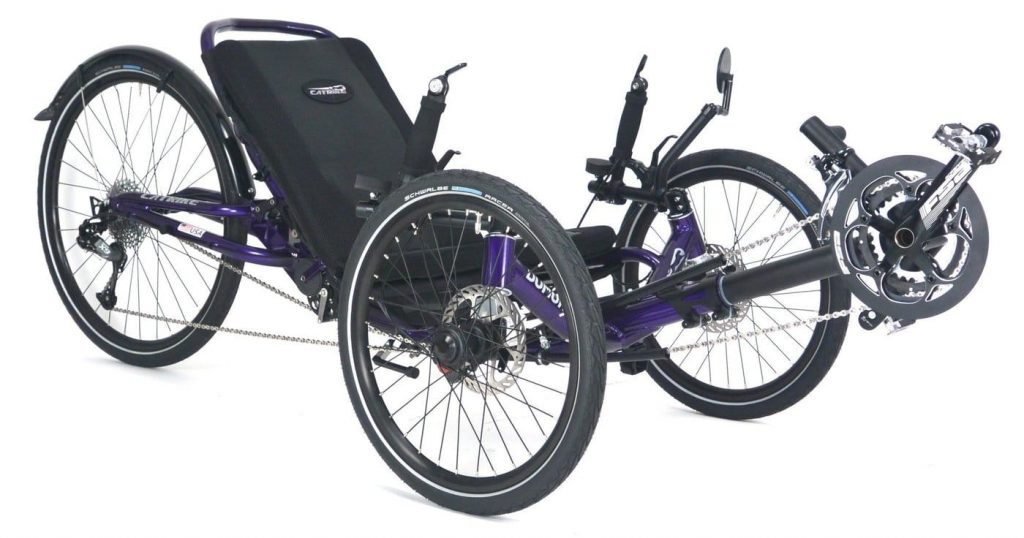
I started out on a Catrike Trail (no suspension), a Catrike 559 (also no suspension), and then a Catrike Dumont (full suspension.) The Cattrikes are well made, steering is very responsive, the Trail, lacking a suspension shows (in my view) a need for (at least) a rear suspension – which is ultimately the direction I went. With a Trail, you feel everything on the road as you pedal.
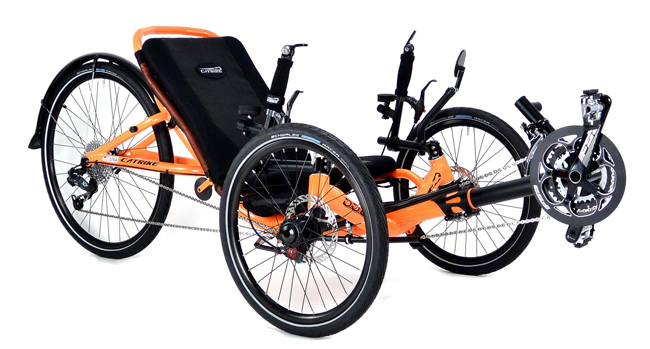
The Catrike 559 sits higher than a Trail. Sitting higher is important for some riders who can experience difficulty exiting a trike with a low seating position. The higher position comes at a potential cost however – if you corner fast, you run a greater risk of tipping over. The Catrike 559 is named for the 26″ wheel in the rear of the bike. Neither the 559 or the Trail have suspension.
The Catrike 559 to me felt more upright than a Trail, and I felt like I had more power. It was definitely easier to get in and out. The height of the 559 caused me to feel more “exposed” than the lower seating Trail.
My reaction while riding the Catrike Dumont was “I could definitely get comfortable on this.”
The Catrike Dumont adds full suspension which clearly dampens the feel of the road. After riding it, I was pretty much sold on the idea of at least partial suspension. While dampening, it did NOT feel “squishy.” Overall, I was very comfortable on a Dumont! Two important points – the Dumont has a lower seating position in contrast to a 559. I was able to get in/out but as you get older, I can see where low seating can be an issue. With practice however, there are more efficient ways of getting out of the trikes seat. Second – the shocks are adjustable – be sure they’re not too “soft” or “hard” for you’re riding style and weight.
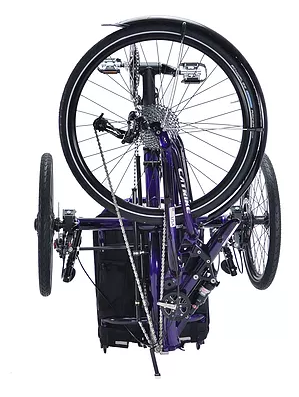
All the Catrike’s can be folded, but must be stored vertically, in other words, you can’t lay them flat. Laying them flat will put too many components at risk of breaking. If you get a Catrike, ensure it can be stored the way it is meant to be!
All of these trikes are available with electric assist – its particularly attractive to helping you climb hills, but the e-assist adds weight, removes the option of a double or triple chainring in the front, and costs (approx.) $2000. extra. I opted to pass on e-assist. I don’t really need it, plus I figure in a few years, e-assist systems will weigh less than they do today and cost less as well.
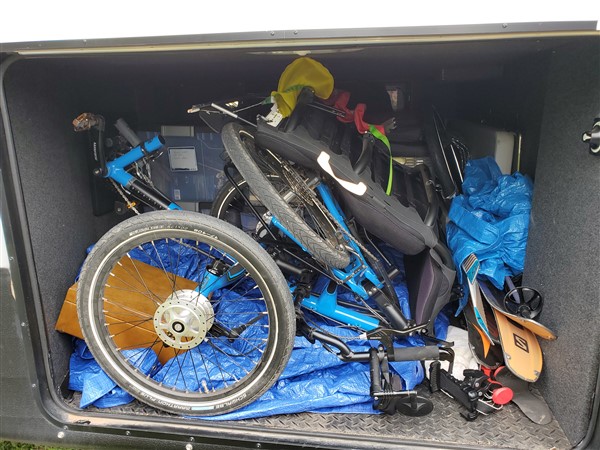
TIP: When you visit a trike store. First, locate one with a good selection of trikes to test ride; Second, use “smart recorder” (a free app) on your smart phone to make an audio recording of your entire experience while test riding. As you ride, make verbal notes to the smart recorder so you record your impressions of each trike you try out. It WILL likely help you greatly in arriving at a solid decision.
ICE Trikes – something I fell in love with INSTANTLY
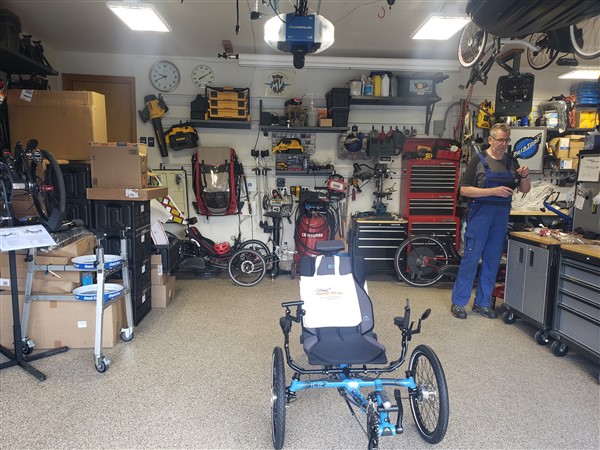
ICE – an overall step up from Catrike. They use a better suspension system than Catrike. ICE uses elastomers for their suspension; Catrike uses a foam that is stiffer (in the front.) I tried a full suspension HD Adventure and an Adventure. The HD is wider (by about 3″) and offers a more stable ride – especially when cornering. There is also a max weight difference between the Adventure & Adventure HD.
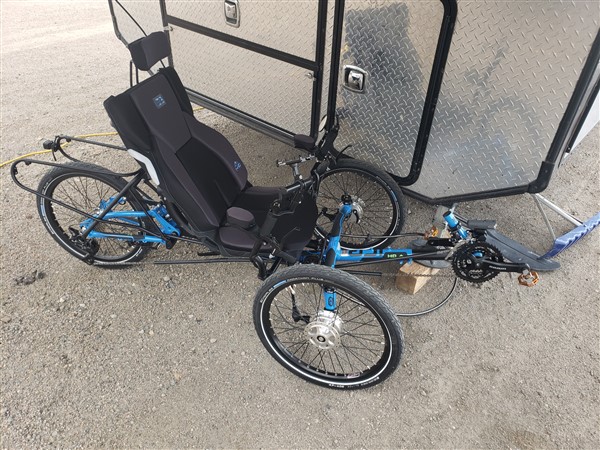
The ICE seat is the MOST comfortable of all that I test rode (same on both Adventure & the Adventure HD) – though the HD’s seat is slightly wider and felt like it “cradled” my shoulder blades. I ride it in the 2nd to most vertical position – there are a total of 4 positions provided.

The ride was smooth and I almost did not feel the need for suspension – though the bikes that had it (ICE can be ordered with no suspension, front or rear only, or full) definitely dampened the ride – a sensation that I personally prefer. The ICE Adventure also seats a bit higher than the Catrike Dumont – hence easier entry & egress.
The most impressive difference in an ICE is the steering – its smoother and more “sure.” The steering on an ICE is “indirect” where the Catrike’s are “direct steering” (I’ll let you research the difference between these two with trikes) – bottom line, the Catrike felt “jumpy” or “skittish” to me in comparison to the ICE which felt very solid.
A few notes about ICE Trikes…
Note 1: Suspensions are NOT cheap. When you go to the ICE site, you’ll see the cost of adding a partial or full suspension to the order. Virtually everything with ICE is configurable – YOU choose whether or not to include each option from tire size (26 vs. 20 rear) to seat/frame size to suspension (none- rear only – front and rear.) Caution: suspensions are NOT cheap!!
Note 2: While ICE trikes are VERY configurable, you can NOT put the Adventure HD seat onto an Adventure frame. We tried it at John’s Trikes and even though it DOES fit, it could impact your ability to turn and ICE will not sell it this way. (I was liking the HD seat and the smaller Adventure frame – but nope, can’t do it!)
Note 3: If you purchase a rigid ICE trike (ie – no suspension), you can later add a front suspension without too much difficulty (other than money – it costs about $1000.), but to add rear suspension requires replacing the ENTIRE rear end of the trike. Message: Decide BEFORE purchase whether you’ll ever want a rear suspension bike. For me, I went with the rear suspension and passed on front; I do not regret that decision at this time after riding for a week or so – including dirt and gravel roads.
The rear wheel: 26 vs. 20 inches
ICE allows you to choose a 26 or 20 inch rear wheel. 26 inch rear wheels are perhaps more comfortable and handle higher speeds better. A 26 will hold its moment of inertia better. 20’s climb better and are overall more nimble. For me, a 20″ rear wheel was desirable as it folds to be slightly smaller than a 26″, thus making it easier to store and transport.
Folding a Trike for transport
The Catrike definitely folded (and transports) best of all – but I refused to let that (completely) control my choice of trike to get. The ICE despite it folding in a way that lifting it is awkward, I have successfully managed to lift it into the storage bay of my 5th wheel. Even with the trike in my storage bay, I am still able to carry quite a bit of cargo! (This is an inherent advantage of a 5th wheel – especially a well designed one like the Outdoors RV and Arctic Fox!)
The Catrike folds so that it can be stood up and rolled on wheels, much like luggage at an airport. It is however meant to be stored vertically; the ICE does not have that challenge when folded. For me, the ICE rode so much better, I opted for its folding quirks and have found its “workable” for my situation.
Final thought on folding: consult the manufacturers specs for size when folded.
Test Riding a few other trikes…
HP Gekko – no suspension; you definitely feel the road. HP Scorpion does have suspension, but its expensive and heavy. I passed on HP Velotechnik. I also found lower back support in the Gekko seat to be lacking.
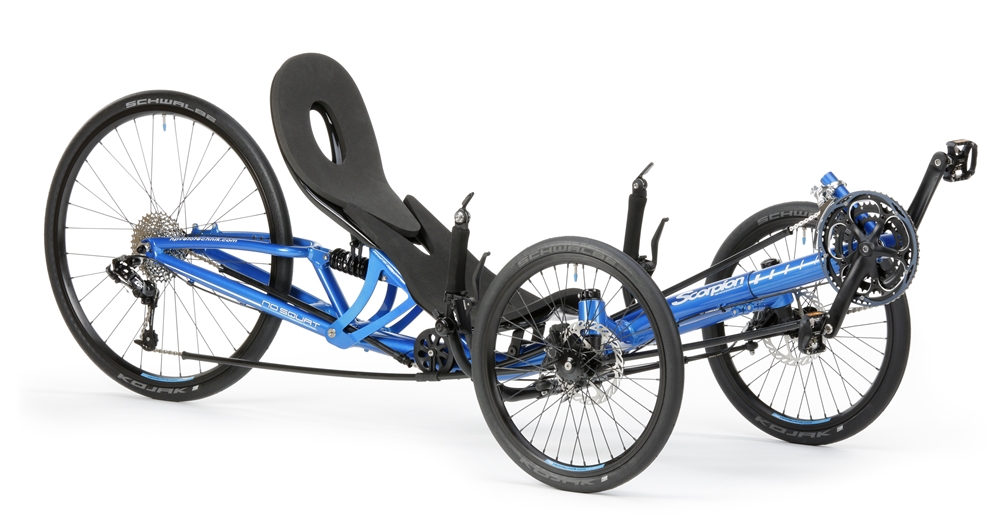
ICE Sprint – a faster, more streamlined bike than the ICE Adventure. I did not like the greater recline in the seating (I prefer to be more upright when I ride.) I rode a 26″ rear wheel, non-suspended model.
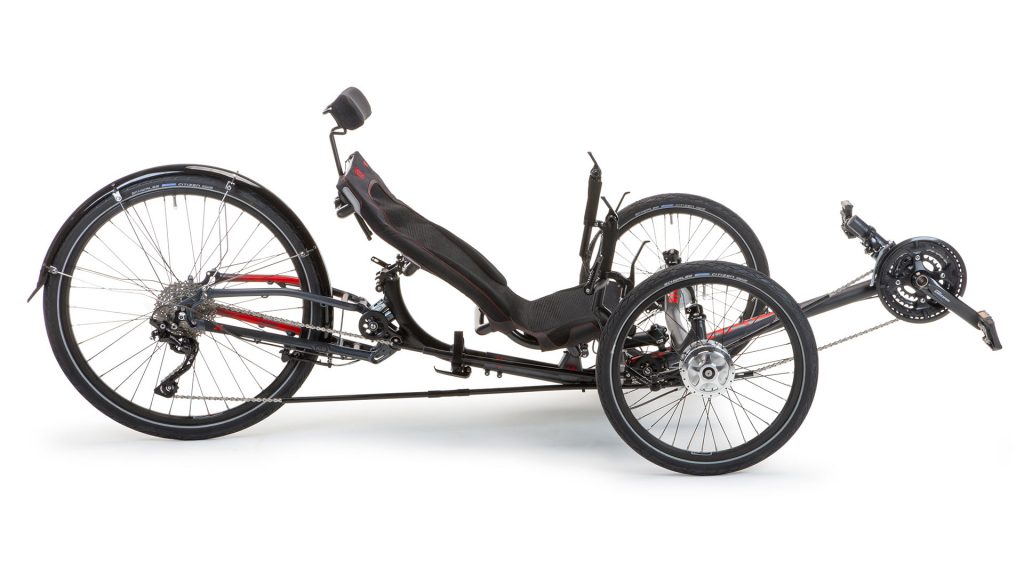
Greenspeed – very responsive steering but I felt like I was going to slide out of the seat! No suspension and you feel the road. The contour did not fit my back very well at all.
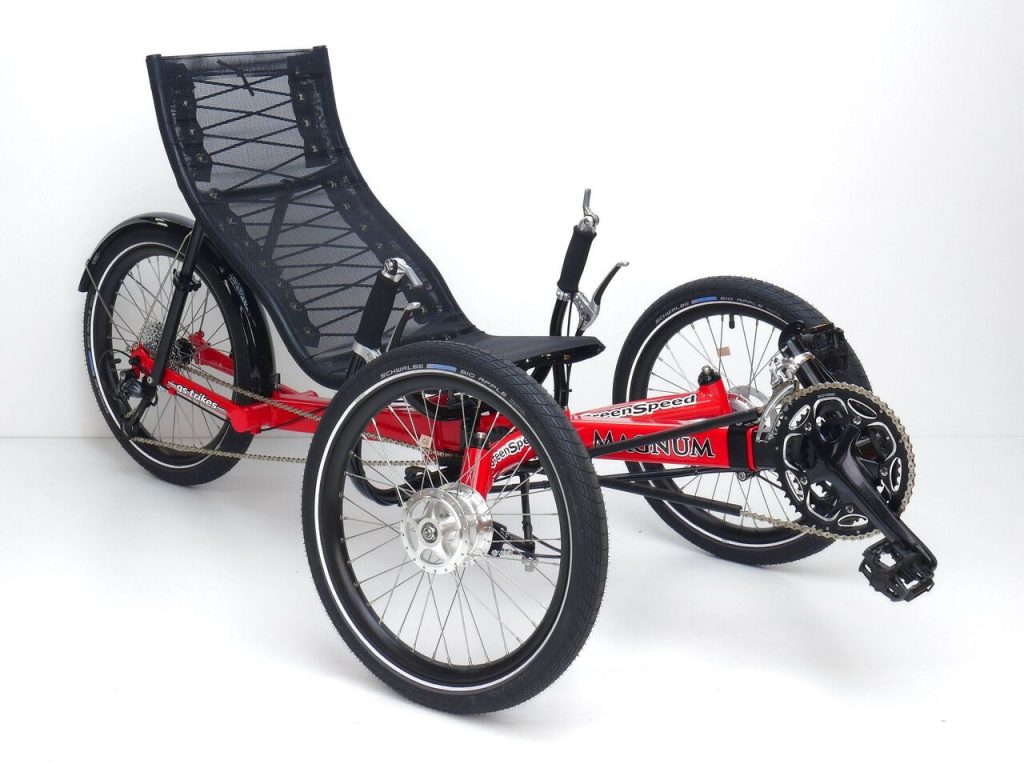
TerraTrike Traveler – less expensive than the others, and it rides like it. No suspension and skittish steering.
E-Assist
I opted against it, but if you do lots of climbing or have physical challenges, electric assist motors will help you to climb hills and save your legs if you tend to “bonk.” Be aware that e-assist adds about $2500. to the trike; adds weight; and limits the chainrings on the front deaurailler.
Which trike worked for me – AND – Whom did I end up buying from?
The ICE Adventure HD. The HD is the same as the ICE Adventure except the HD is about three inches wider and can accommodate a bit more weight. The HD seat “felt right” to me and was the most comfortable of all I rode. Although I didn’t test ride a rear suspension model, I reasoned I only needed rear suspension – and my bet paid off, I LOVE the way it rides and do not need front suspension (which would add about $800. to the cost of the trike.)
I did not go with e-assist (ego?) – I liked the idea that the bike comes with a triple ring up front and you lose that with e-assist, not to mention, e-assist adds about $2500. and as noted earlier adds several pounds to the bike. I figure if I need e-assist in the future, it will cost LESS then than it does now and it will weigh less due to improvements in battery technology. Lastly, I went with a 20″ rear wheel – primary reason? How it folds to a smaller footprint than the 26″ model. Not only is it an easier fit into my 5th wheel, its easier to handle when you have to lift it into the storage bay.
When I realized when my trike was due to come in, I knew I would be FAR from Texas so I set out to find a GREAT trike dealer and I found one in the Recumbent Trike Store of Longmont, Co. June and Michael are the proprietors and did a great job advising me on the myriad of choices I had when ordering my ICE Trike along with taking the time to set it up once it arrived. They were patient and kind and very fair.
As I noted, they, the Recumbent Trike Store are primarily an ICE Trike shop – so if you want to jump right to the best, they’re the dealer for you – especially if you’re anywhere near (within hundreds of miles) of the Front Range in Colorado. Remember, many of the other brands I test rode – one of which may be “the one” for you (due to budget or style) – you may want to talk to Johns in Lancaster, Tx.
What do recumbent trikes cost?
You can buy a chinese built trike for as little as just over $1000. new. ‘Nuf said about that? Terra Trike and Catrike are both American made and cost anywhere from about $2000 to a bit over $4000. ICE, made in England starts at about $4000 and can go into 5 figures if you totally deck it out! Some of the German trikes (HP) are in a similar or higher price range than ICE trikes. Consider used! IF you can find one, it may very well be 30-50% less than a new model! Of course… look at it this way – what will you SAVE if you avoid just ONE cardiac event??
Off-Road Riding and Trikes
My ICE Adventure HD has heavy duty 1.75″ Marathon Plus tires. I ride gravel next to a railroad bed here in South Dakota with no issues. I’ve hit finer gravel and I’m still ok, but the mother of all off-road trikes I’ve seen is the ICE FAT – see below!
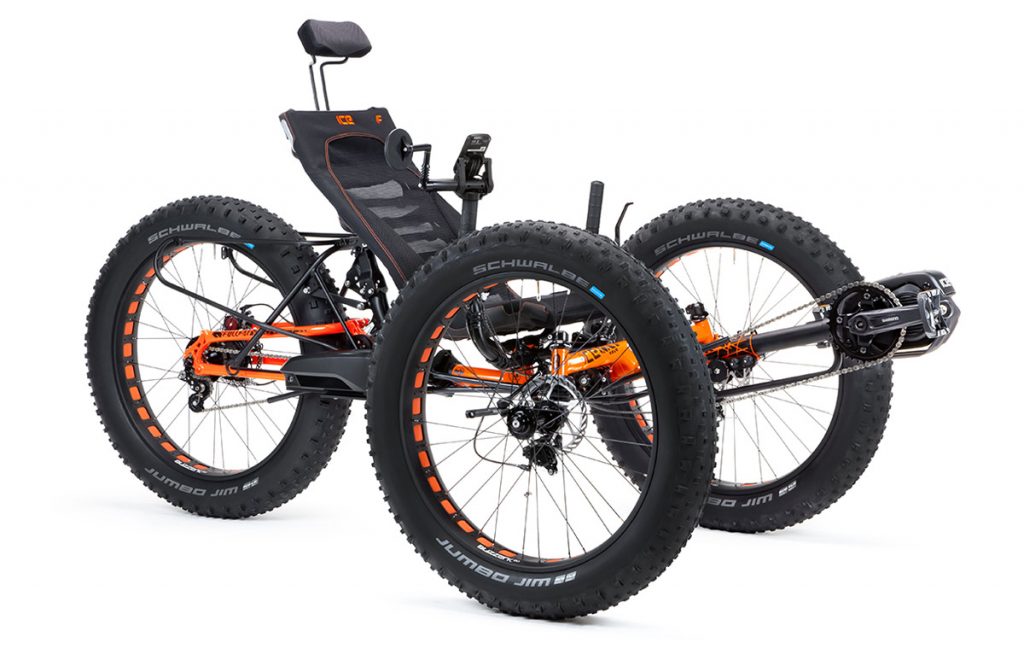
The Black Hills – Where I am now – and Affordable/uncrowded campgrounds…
Please allow this to serve as a BRIEF introduction to Edgemont and the Black Hills. Bike/trike riding for “seasoned citizens” is a great way to keep the blood flowing and stay in shape. Trikes offer UNPRECEDENTED safety AND comfort. This combination increases the odds you remain uninjured and keep riding – daily??
In part, I seek out areas where there is good riding. I’m currently in Edgemont, SD – a small town on the edge of the Black Hills that also serves as the gateway to the Mickleson Trail – a foot and bike trail that runs 100+ miles through the black hills. I’ve been here for a couple of weeks, and plan to stay a couple more. The town has only about 500 residents, there’s not much here EXCEPT quiet roads, flat ground and good people (and a bar and two restaurants!) I will definitely return here. As noted, in my next post, I will provide much more detail about this region.
Closing Thoughts…
Full time RV’ing is a lifestyle, NOT a vacation. I work each day (I have Concierge RV clients who come aboard at a regular pace now – looking for me to find them the right camper at the best possible price OR to sell theirs), I also am building THIS WEBSITE! My goal is to provide valuable and worthwhile information. Beyond that, I’m biking, kayaking, and on some days, sight-seeing.
Liked this? Please consider joining my newsletter below. Be aware, I have more content to share – MUCH more soon! I’m developing some strong thoughts on RV fridges I plan to share, a review of my camper as it approaches 4 years old, and more. Also stay tuned SOON for my comments on Edgemont and the Black Hills as a GREAT RV destination.
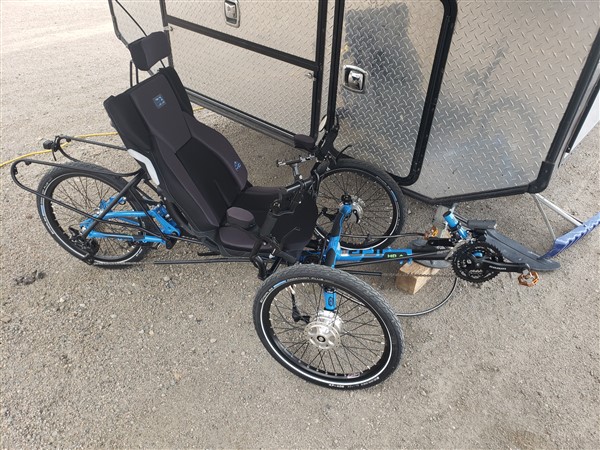

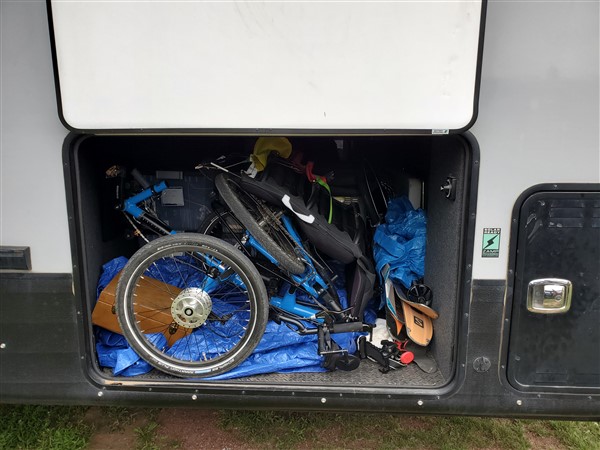
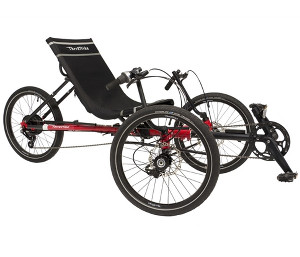
Nice write up Alan. I had a similar experience, except mine was on a regular bike, was laid up for 3 1/2 months. After that I got a Lightning Phantom two wheeled recumbent and now a recumbent trike. We carry 2 Catrike Villagers that I recently electrified using Utah Trikes, Catrike conversations @ $1,500 each. They travel on a custom piggyback rack inside our Micro Minnie 2106DS that I built and fits in the slide room. When we get to our destination, we move them to our Hitch Rider Double Decker rack that we carry on the back of the Micro Minnie. We are recently retired and only camp a week or two at a time. Looking forward to your future trike tells.
Fred, thanks for sharing! Not sure I’d want to be moving those trikes in/out of a Micro Minnie trailer. Won’t they travel well on the hitch rider rack? And yes, more stories coming soon! Al
Yes, I could carry them on the rack, but I’m not a big fan of having them out in the weather while traveling. We have covers for them when they’re stationary on the rack. Moving them in/out isn’t too bad. I remove the wheels which makes them easier to maneuver in/out.
Congrats Alan and thanks for the great write-up. That’s a nice looking bike! Enjoy the low drag experience.
thanks Ken! Definitely low drag. Al
Looking forward to this. Left a comment on the facebook post. I am wondering why you chose a 5th wheel as opposed to a class C… or even B? Thanks!!!
Kishana,
The long answer is here – https://rvacrossamerica.net/choosing-the-right-type-of-rv-how-to-buy-a-rv-part-3/ – the short answer… massive storage; a big truck to travel with; lots of living space. Much more in my post that details the types of campers and their relative merits. Be sure to watch the video as well. Al